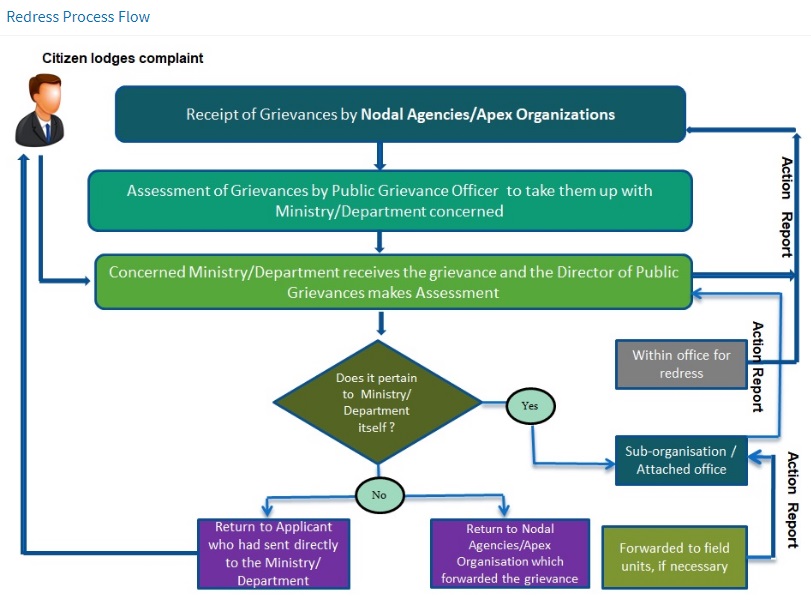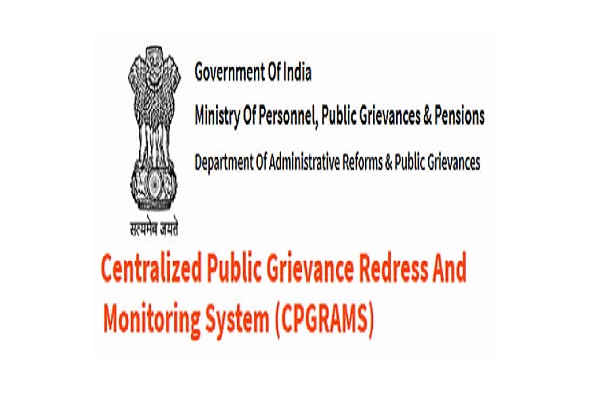This is a Government of India Portal aimed at providing the citizens with a platform for redress of their grievances. If you have any grievance against any Government organization in the country, you may lodge your grievance here which will go to the Ministry/Department/State Government concerned for immediate redress.
Centralized Public Grievance Redress And Monitoring System (CPGRAMS) is an online web-enabled system over NICNET developed by NIC, in association with Directorate of Public Grievances (DPG) and Department of Administrative Reforms and Public Grievances (DARPG). CPGRAMS is the platform based on web technology which primarily aims to enable submission of grievances by the aggrieved citizens from anywhere and anytime (24x7) basis to Ministries/Departments/Organisations who scrutinize and take action for speedy and favorable redress of these grievances. Tracking grievances is also facilitated on this portal through the system generated unique registration number.
The CPGRAMS platform is now available on UMANG App too.
The grievances received by the Department are forwarded to the concerned Ministries/Departments/State Governments/UTs, who are dealing with the substantive function linked with the grievance for redress under intimation to the complainant. The Department ‘takes up’ about 1000 grievances every year depending upon the seriousness of the grievance and follows them regularly till their final disposal. This enables the Department to evaluate the effectiveness of the grievance redress machinery of the concerned government agency.
(Also read: Revised CBSE Affiliation Bye Laws releases by HRD Minister to ensure speed, transparency, hassle-free procedures)
Note:
1. All grievances relating to State Governments / Union Territory Administrations and Government of NCT Region of Delhi, are to be redressed by the State/ UT/ NCT Government concerned. Citizens are advised to take up matter regarding pendency of their grievance directly with the State Government concerned.
2. If you have not got a satisfactory redress of your grievance within a reasonable period of time, relating to Ministries/Departments and Organisations under the purview of Directorate of Public Grievances (DPG), Cabinet Secretariat, GOI, you may seek help of DPG in resolution.
3. Any Grievance sent by email will not be attended to / entertained. Please lodge your grievance at the website.

(Also read: Online Safety Tips for Parents, Youngsters and Organisation)
FAQs relating to PG Portal:
Que-1: What are the contact details of the Department of Administrative Reforms and Public Grievances?
Ans: Department of Administrative Reforms and Public Grievances, 5th floor, Sardar Patel Bhavan, Sansad Marg, New Delhi – 110001
Website: www.darpg.gov.in
Tele fax : 23741006
Que-2: Where can the grievances be sent?
Ans: The grievances can be sent to :
The Department of Administrative Reforms and Public Grievances (DAR&PG) (pgportal.gov.in)
The Department of Pensions and Pensioners’ Welfare (DP&PW) (pgportal.gov.in/pension/)
The above nodal agencies receive grievances online through pgportal.gov.in as well as by post or by hand in person, from the public.
Que-3: How do I lodge the grievance?
Ans: The grievances can be lodged online. In cases where internet facility is not available or even otherwise, the citizen is free to send her/his grievance by Post. There is no prescribed format. The grievance may be written on any plain sheet of paper or on a Postcard / Inland letter and addressed to the Department.
Que-4: What happens when I lodge the grievance?
Ans: The grievance is acknowledged online or by post. A unique registration number is given to each grievance.
Que-5: How do I track my grievance?
Ans: It may be tracked on the pgportal by clicking on “View Status” tab.
(Also read: Home Ministry launches portal for reporting Online Sexual Abuse and Cyber Crimes)
Que-6: What happens to the grievances? How are the grievances dealt with in Central Ministries/Departments?
Ans: Every Central Ministry / Department has designated a Joint Secretary or a Director / Deputy Secretary, as its ‘Director of Grievances’. He / She is the nodal officer for redress of grievances on work areas allocated to that particular Ministry / Department.

Que-7: After redress, can the grievance be re-opened for further correspondence about it having been closed without details etc.?
Ans: No. In such situations, the citizen will have to lodge a fresh grievance drawing reference to the closed grievance, and call for details. Sometimes, the details are sent by post and mentioned in the final report. The postal delivery may be awaited before lodging a fresh grievance
Que-8: What are the contact details of the Nodal Officers of Public Grievances in Ministries/Departments?
Ans: The list is accessible on the Department’s website at In addition to this, it is also available in the Citizen’s Charter of the Ministries/Departments hosted on their websites.
Que-9: What is the system of granting personal hearing on grievances?
Ans: Every Wednesday of the week has been earmarked for receiving and hearing of grievances by the Director of Public Grievances in person.
Que-10: What are the types of grievances which are not taken up for redress by the Department?
Ans: 1. Subjudice cases or any matter concerning judgment given by any court.
2. Personal and family disputes
3. RTI matters
4. Anything that impacts upon territorial integrity of the country or friendly relations with other countries
5. Suggestions
Que-11: What is the role of Department of Administrative Reforms and Public Grievances (DARPG) with reference to the grievances concerning Central Ministries/Departments/ Organizations?
Ans: The Department of Administrative Reforms & Public Grievances is the chief policy making, monitoring and coordinating Department for public grievances arising from the work of Ministries/Departments/Organizations of the Government of India. The grievances received in the department are forwarded to the Ministries/Departments concerned. Redressal of grievances is done by respective Ministries/Departments in a decentralized manner. The Department periodically reviews the status of redressal of public grievances under CPGRAMS of Ministries/Departments for speedy disposal of grievances / complaints.
Que-12: What is the role of Department of Administrative Reforms and Public Grievances (DARPG) with reference to the grievances concerning State Government?
Ans: All grievances relating to State Governments / Union Territory Administrations and Government of NCT Region of Delhi, are sent to the State/ UT/ NCT Government concerned. Citizens may take up matter regarding pendency of their grievances directly with the State Government concerned also.
Que-13: What is the time limit for redress of grievance?
Ans: Sixty (60) days. In case of delay an interim reply with reasons for delay is required to be given.
Que-14: What action can be taken by me in case of non-redress of my grievance within the prescribed time?
Ans: You may take up the matter with the Director of Public Grievances of the Ministry/Department concerned whose details are available on the pgportal.
(Also read: UIDAI introduces "Masked Aadhaar" feature to eAadhaar)
(Also read: Not a single mobile phone faces disconnect threat, says DoT)
(Also read: CSIR develops affordable Water Disinfection System known as Oneer)
(Also read: No Cost EMI is not interest free, know how No Cost EMI works)
(Also read: NITI Aayog launches guidelines for PPP in treatment for Non-Communicable Diseases)
For more updates:
1. Like our Facebook Page
2. Join our Telegram Group
3. Join our Facebook Group
4. Subscribe to our Youtube Channel
5. Follow us on Twitter
6. Follow us on Instagram
Disclaimer: The above post includes some content used from CPGRAMS website and executed on this website for fair use only. As this website is of educational nature, hence the content is used for education and awareness to the public.

